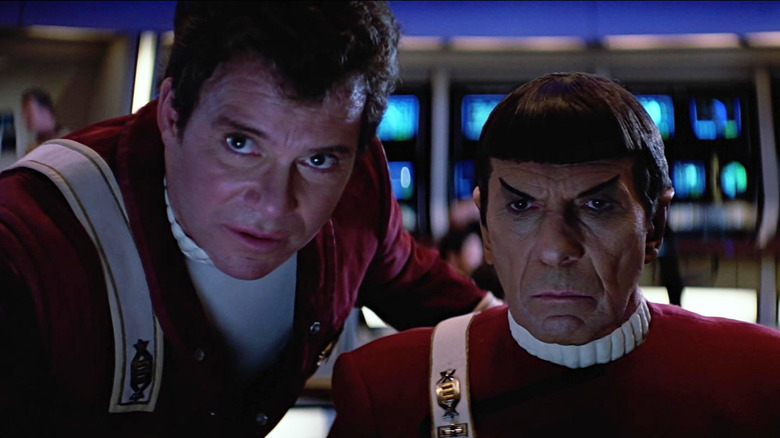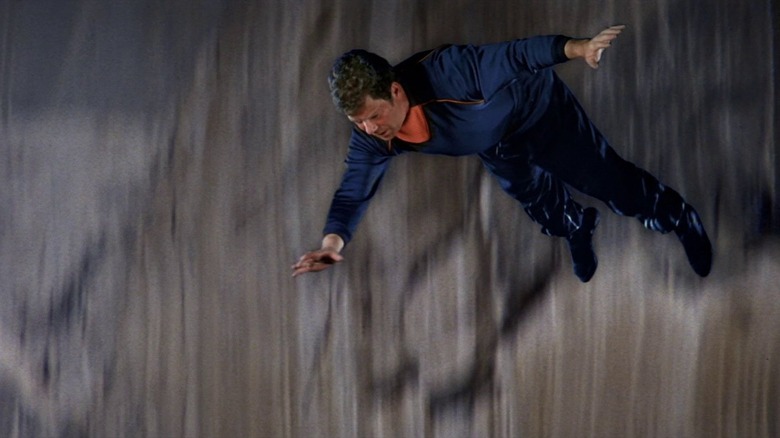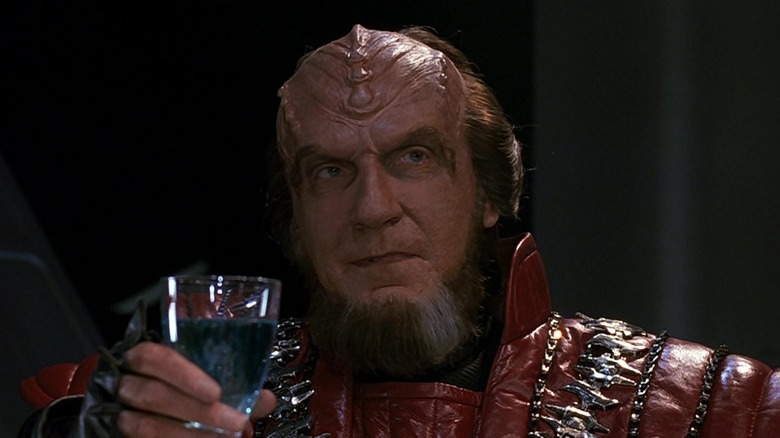Why Star Trek V: The Final Frontier's Troubled Production Almost Killed The Franchise
William Shatner's 1989 space epic "Star Trek V: The Final Frontier" is still, to this day, cited as one of the worst "Star Trek" movies. The film's hefty $30 million budget likely went mostly to its cast, as its visual effects are severely lacking and the sets look shoddy and cheap. Likewise, the scenes featuring the planet Nimbus III and its Paradise City were very clearly just shot out in the Mojave Desert, and there was compositing for the film's many viewscreen shots, forcing Shatner to shoot actual projection screens. (It doesn't look good.)
"The Final Frontier" was beset with myriad production problems as well. Right when shooting began, there was a strike by the Teamsters Union, forcing Paramount to seek out non-union drivers in a move that was, of course, meant to invite Teamsters retaliation. (It may not be related, but one of the trucks was blown up in a parking lot shortly before a location shoot.) Also, the studio couldn't afford its usual team of effects wizards at Industrial Light & Magic, so it had to hire a much cheaper team of technicians at the last minute. This was all on top of Shatner making questionable directorial decisions throughout, at least according to producer Harve Bennett (who has spoken very candidly about the film's failure).
Admittedly, the film's premise is a big swing, as it involves a terrorist named Sybok (Laurence Luckinbill) hijacking the USS Enterprise and taking it to the center of the galaxy, where he believes God (!) lives. The movie even climaxes with Sybok and the Enterprise's crew facing a being that could potentially be the physical manifestation of the Almighty. "Star Trek" has always been interested in asking big, philosophical questions about the nature of the universe, but facing God head-on seemed kind of silly, even to longtime Trekkies.
Ultimately, "The Final Frontier" bombed at the box office, grossing an unimpressive $70.2 million (compared to the $133 million that Leonard Nimoy's "Star Trek IV: The Voyage Home" had made). For a moment, it looked like the "Star Trek" film series was at an end.
Star Trek V was almost the final frontier for Star Trek
In 1989, the subtitle "The Final Frontier" implied that, yes, this would indeed be the last "Star Trek" movie. It was also a reference to Shatner's opening narration of the original "Star Trek" TV series, bringing everything full circle. More than that, its premise was so expansive that it really felt like, well, the final frontier of human consciousness. Space can be traversed easily in "Star Trek," but the infinity of the human soul remains largely unexplored. Shatner was allowed to pitch the premise of the film himself, as a pay dispute on the set of "The Voyage Home" allowed him to make certain contractual demands. It was stipulated that Shatner could not only direct "Star Trek V," but he could also put together script treatments. As such, it was his idea to have the film be about meeting God face-to-face.
After the movie tanked, though, it was unclear where the franchise would go. Bennett began working on a reboot of the property, which was to feature Kirk and Spock as young men at Starfleet Academy. They were to be played by new actors, and the film series would be allowed to begin afresh. Sadly, Bennett's "prequel" idea was scrapped after there was a regime change at Paramount, and the new management discarded his concept. A 1991 issue of Cinefantastique Magazine also quoted Bennett as saying that he, at one point, he was working on a "Star Trek" movie heavily inspired by the 1940 Michael Curtiz Western "Santa Fe Trail," but that too was discarded amidst the managerial swap. Bennett's notion of rebooting the property with a young new cast would, of course, eventually be used in 2009 for J.J. Abrams' "Star Trek."
Ultimately, though, the new Paramount regime felt that "Star Trek" should be redeemed and decided to gather the original series' cast one last time for a proper "Final Frontier."
The road to Star Trek VI: The Undiscovered Country
Bennett stepped away as a producer because his projects were killed off, but it was very possible, for a few glimmering moments, that "Star Trek" could've been rebooted as early as 1990. This was when "Star Trek: The Next Generation" was already on the air, so it very much seemed that the public didn't want to watch the original "Star Trek" cast anymore. The franchise would have restarted in earnest, and Kirk and co. — at least as we had come to know them — would have been laid to rest. It would have been a bold move — one that Paramount wouldn't have the chutzpah to pull off for another 19 years.
Paramount's new regime in 1990, however, was more concerned with salvaging what the property already had rather than falling into the reboot trap. The studio hired Nicholas Meyer, the writer/director of the hit "Star Trek II: The Wrath of Khan" and a crucial contributor to the script of "The Voyage Home," to handle an all-new production featuring the original "Star Trek" cast. Meyer put together "Star Trek VI: The Undiscovered Country," a post-Cold War allegory that was staged like a political thriller. It was all about the fall of the Klingon Empire, meant as a clear parallel to the collapse of the Soviet Union in 1988. This setup was more timely than the one for "The Final Frontier," in addition to being more intimate from a character perspective. Some feel "The Undiscovered Country" might even be one of the best "Star Trek" movies ever. It was certainly a much, much better ending for the original "Star Trek" cast than "The Final Frontier."
The next "Star Trek" film after that, 1994's "Star Trek Generations," was a "Next Generation"-inspired movie that featured Shatner in a supporting role. Meanwhile, Bennett went on to create the pretty-good time traveling cop TV series "Time Trax" in 1993 and even worked with Steven Spielberg to develop the little-discussed animated series "Invasion America" in 1998.


